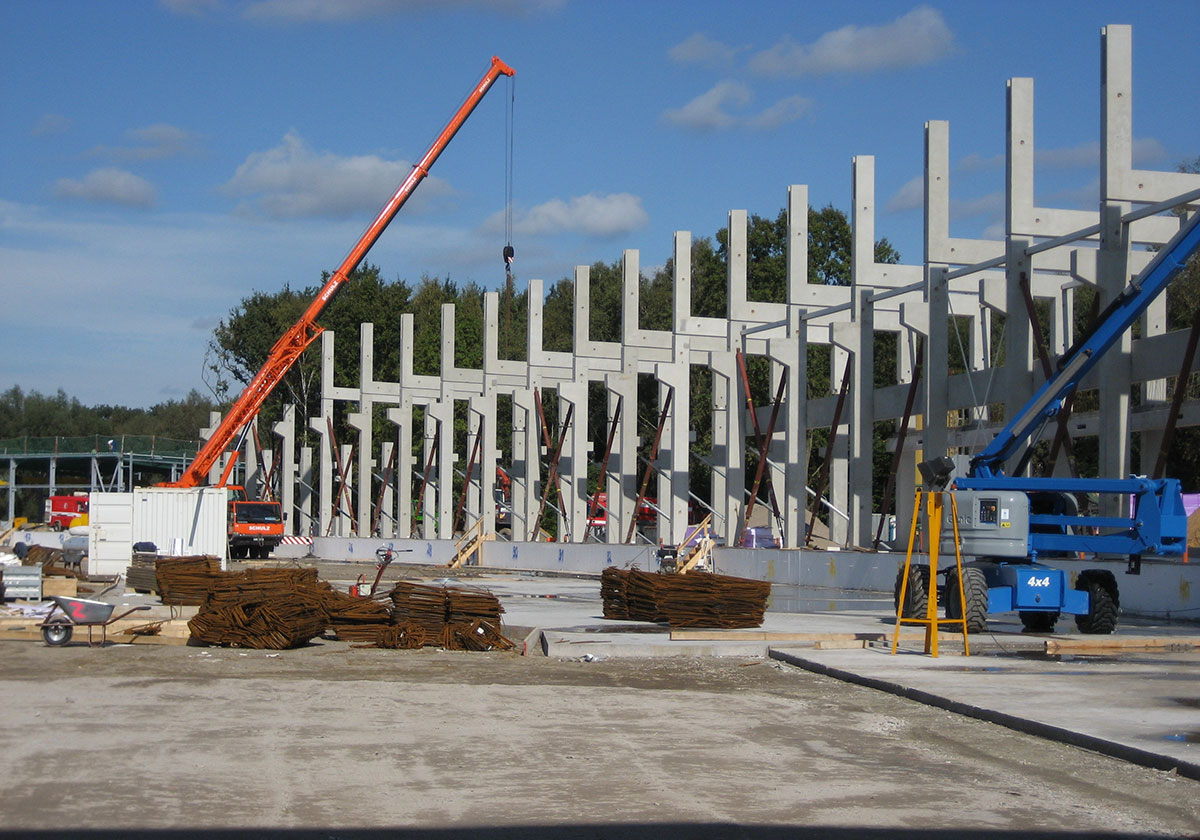
DESY, the German Electron Synchron, is a research center of the Helmholtz Association. In the west of Hamburg, DESY builds and runs particle accelerators and laser sources several kilometers long. More than 2.000 employees and around 3.000 visiting scientists from many nations work in laboratories, research and administration buildings as well as in the scientific and technical workshops. Today, DESY Hamburg is one of the world’s leading large-scale research centers in X-ray laser, particle and accelerator physics.
Since 2005, GuD has been involved in the preparation and construction of several large projects on the DESY site.
PETRA III Experiment hall
PETRA III is currently the world´s brightest storage ring-X-ray source. The beam lines open into the approximately 300 m long and 40 m wide PETRA III hall with up to 30 experimental stations. There, the X-rays hit exactly on extremely small samples and produce for example pictures of nanostructure and molecules. A special deep foundation of the floor slab, made over the entire length of 300 m in one piece of special concrete, shields the experimental stations against vibrations from the environment and the hall itself. The hall construction, as well as their space and utilization concept had to be designed with the least possible influence on the experimental stations.
Centre for Free Electron Laser Studies (CFEL)
(CFEL) A multi-storey research building with a total of approximately 3.500 m2 of laboratory space was built for CFEL. Approximately half of these laboratory spaces are used as laser measuring chambers, so that high demands are placed on the deformation stability and freedom from vibration of these rooms.
Free electron laser FLASH II
FLASH generates extremely intense, ultrashort X-ray laser flashes in a 315 m long tunnel with linear accelerators, which hit examination objects in two experimental halls. In the FLASH II project, the tunnel was extended and the second experimental hall was built with six experimental stations.
Research Center of the Max Planck Institute for the Structure and Dynamics of Matter (SDMA)
The research building with one lower and four upper floors is 135 m long and 37 m wide. The total gross area is 12.400 m2. The construction costs are estimated at about 37 Mio. euros. Completion and handover are scheduled for the summer of 2019. Laboratories, offices and garages should be located in the building. In the basement, the establishment of highly vibration-sensitive laser workplaces is planned, further vibration-sensitive laboratories are planned on the upper floors.
PETRA III Experiment hall
- supplementary subsoil exploration, report on background conditions
- pressure-settlement examinations, settlement calculations for different foundation variants
- design planning for the foundation, planning and construction of a special deep foundation on double-walled large bored piles
- detailed design for the monolithic, one-piece manufactured base plate with special reinforcement
- vibration measurements on the construction site for the registration and assessment of microseismic stimulation from traffic, industry and environmental movements
- depth-depending determination of soil dynamic parameters (wave propagation velocities, shear and e-modul) using seismic procedures
- forecast calculations for vibration transfer to the base plate of the experimental hall using numerical half-space models and 2D finite-element models
- dimensioning of the base plate and its foundation with regard to minimum vibration absorption from the subsoil or the environment
- structural dynamic calculation for the determination of the vibration behavior of the hall construction under dynamic stimulation by the operation of the domestic technical units
- compaction control on the construction field, trail loading of foundation piles
- construction supervision in the production of the founding and production of the base plate in cast iron
- measurements on the base plate in the finished hall to control vibration immissions
Centre for Free Electron Laser Studies (CFEL)
- vibration measurements on the DESY-area at three possible locations
- description and comparison of microseismic stimulation at the three sites
- recommendation of a location according to vibration-technical criteria
Free Electron Laser FLASH II
- vibration measurements on the building site for detection and evaluation of microseismic stimulation
- investigations on possible vibration exposures on FLASH I from the construction of FLASH II, recommendations for the construction
- determination of soil dynamic parameters ( wave propagation velocities, shear and E-modul) using seismic procedures
- structural-dynamic calculations for the design of the bearing structure of the experimental hall FLASH II
- constructive optimization of the bearing structure with regard to minimal component vibrations in the experimental areas
Research center of the Max-Planck Institute for the Structure and Dynamics of Matter (SDMA)
- subsoil investigations and preparation of the geotechnical report
- grid sampling concept for the exploration of the substrate and contaminated site situation
- settlement calculations for the foundation slab
- recommendations for the construction of the foundation and construction of the excavation pit
- vibration measurements on the construction field for detection and evaluation of microseismic stimulation
- forecast calculations for the vibration transfer to the foundations or base plate based on numerical half-space models
- dimensioning of the base plate and its foundation with regard to minimum vibration absorption from the subsoil or the environment
- implementation of structural dynamics calculations for the analysis and optimization of the vibration behavior of the bearing structure
- implementation of measuring investigations for the dynamic stimulation by workshop machines (i.a. CNC-milling machine) from planned repair shops in the neighborhood














